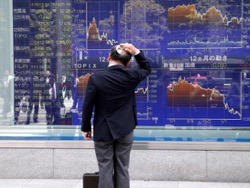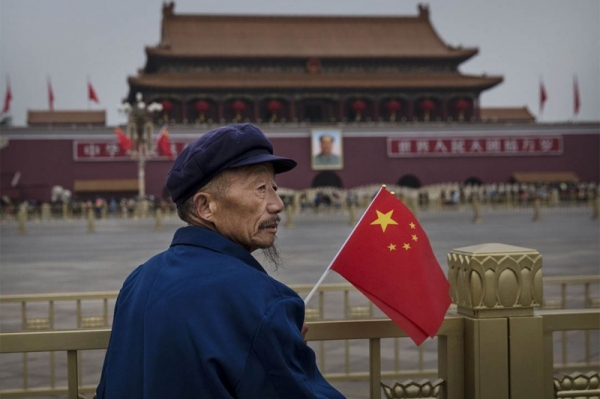
China seriously involved in debt. Such a conclusion can be drawn from the statement of the Deputy head of the International monetary Fund (IMF) David Lipton. Speaking on Saturday, April 11, in the southern Chinese city of Shenzhen, Lipton noted that the losses of Chinese banks from-for debts of state-owned enterprises can reach 7% of GDP.
“Corporate debt is around 145% of GDP, which is a lot by any standards. According to the IMF’s calculations, about 55% of the total volume of corporate debt — a debt of SOEs. Due to the slowdown in economic growth in China and growing debt companies is becoming increasingly difficult to pay suppliers and service debt. The banks held more delinquent loans, and losses are inevitable,” — said the Deputy head of the IMF.
According to official statistics, bad debts amount to only 1.7% of the total loan portfolio. But in reality the numbers are much worse. Thus, the IMF estimates their level of 15.5%.
I must say, fighting with “bad” debts — one of the major goals of Beijing. In just two months, by the end of April, Chinese monetary authorities have implemented a program of writing off bad debts in exchange for shares of more than $ 220 billion.
But in fact these actions are similar to struggle against windmills. Sooner or later the manipulation of non-performing loans will lead to acute problems though, because to force strong banks to invest in shares of troubled banks means to take away their potential profits. According to Western analysts, replacing one bad asset for another, the Chinese authorities bought a few quarters of delay. But debt bomb, associated with non-performing loans, in any case, it will explode, unless there are structural changes.
The Chairman of the people’s Bank of China (PBOC) Governor Zhou Xiaochuan at the conference of China Development Forum openly admitted that the overly high debt of Chinese companies creates macroeconomic risks. And in early March, Moody’s warned that it may downgrade the credit rating of China in connection with rising debt and declining foreign exchange reserves.
Some economists are already saying that perhaps the world is entering a third acute phase of the global crisis (the first — mortgage crisis in the United States in 2007-2009, the second — the Euro crisis in 2011-2012), and her reason was, as before, to a simple phenomenon — an overabundance of debt. Only this time the trigger of the global collapse will be the cooling of the Chinese economy and a sharp outflow of capital from China, and the brunt of this wave will be applied to developing markets, including Russia.
In fact, the prospects and risks of China?
— China’s relative debt level is higher today than the United States, like the Chairman of Russian economic society. SF Sharapova, Professor of international Finance MGIMO Valentin Katasonov. — According to the Bank for international settlements, the total debt of China — indebtedness across all sectors of the economy, including manufacturing, banking, and the household sector — in the third quarter of 2015 amounted to 249% of GDP — against 248% of GDP, the United States and 270% in the EU. The Chinese debt is growing rapidly: by the end of 2007, the total debt of China did not exceed 148 percent of GDP.
The current relative debt of China higher than the US on the eve of the mortgage crisis of 2007. So, in my opinion, now the world economy can “take off” in one of the three centres: America, Europe, and China.
Noticed I never shared the enthusiasm about the “Chinese miracle”. Personally to me the Chinese economy reminiscent of the bubble, inflated by a pump called a printing press of the fed. China developed exclusively for debt money, and the reverse side of the “miracle” — a huge external and internal debt of China, which today it is impossible even to maintain.
And we need to understand the debt pyramid starts to crumble just when starting to run out of money to pay current interest. In this pyramid there is a refinancing of old debts with complex interest, which exacerbates the situation.
So China really can take off at any moment.
“SP”: — What can trigger the collapse?
— A hike in interest rates by the fed. Let me remind you that members of the Federal open market Committee of the fed at the meeting of April 26-27, discussed a possible rate hike at its next meeting to be held on June 14-15. If the fed will raise the rate by 0.25% (it was the first time in 9 years increased by the fed in December 2015 — until the range of 0.25−0.5%), it will have serious consequences for the world economy, including China.
Let me remind you: rate hike in 2015 led to the frenzied outflow of capital from China. And there are serious concerns that the repetition of this scenario will be for the Chinese economy the last straw and lead to its collapse.
“SP”: — In the IMF understand this?
I understand perfectly, and not only in the Fund. Sunday in Dresden concluded the work of the annual conference of the Bilderberg club, the private Playground of the elite of Europe and North America. The content of the discussions at the meetings of the Bilderberg club remains deeply sensitive. But, I am sure that the main issue that was discussed was to raise whether the fed base rate. It is no coincidence that at the meetings in Dresden was attended by the managing Director of the IMF Christine Lagarde.
Lagarde, by the way, does not hide that opposes the rate increase. And she holds this position because he knows that the world is now arranged so that no matter where the rush because when you rush will collapse the entire global economy: U.S. and Europe, and China.
But, in my opinion, of the trio is China the weakest position. Now all eyes are on Europe for a possible British exit from the European Union (the so-called Brexit). Let me remind you that a referendum on Britain’s membership of the EU will take place on June 23. In this situation China was in the information shadow, but that doesn’t make him less explosive.
“SP”: — What we will see if China’s economy starts to crumble?
— The collapse of the Chinese stock bubble. This will result in mass bankruptcies and rising unemployment in China. And then the crisis spread from the stock market on China’s real estate market — he’s too pretty overheated, that will cause a huge debt defaults on the part of construction companies that took loans in the hundreds of billions of dollars. In this scenario, the yuan rapidly roll down.
But then, I think the crisis will spread first in developing economies, then the EU and the USA. The fact that the Chinese government will certainly try to save myself, and try to use foreign exchange reserves. This means that will start a mass dumping of securities, primarily Treasury bills of the United States. This could have very serious consequences for America.
“SP”: — Russia in this case will suffer?
— With an increase in the fed rates money from all emerging markets, including Russia, will rapidly go to America. To us it is unprofitable. Now we think we stabilized the ruble, but in the case of the collapse of China the ruble is also going to plummet. A sharp depreciation of the national currency is always a disaster…
— On the background of low growth of the world economy the pace of China cause the other players outright envy, — said the Deputy Director of the Institute for Far Eastern studies, member of the European Association of sinologists Andrew Ostrovsky. — Let me remind you that in 2015, China has achieved a growth of 6.89% of GDP, and went from third to first place in the world. The United States showed growth of just 3% of GDP, EU — less than 1% of GDP.
If we talk about debt, the national debt of China is less than 60% of GDP. This is quite acceptable, compared with the same US. Moreover, we need to distinguish between so-called local debts of the provinces, and the debt of the Central budget. Notice that the Central budget of China is traditionally in surplus, and the local shortage. To cover the debts of local budgets, at the March session of vsekitajsky meeting of national representatives (NPC) of the 12th convocation it was decided to allow the authorities of all 31 provinces to issue bonds totaling 3.2 trillion. yuan. And this will largely solve the debt problem.
No special sharpness and bad debts of enterprises. Start with the fact that the statistics of the IMF and the official Beijing is not the same due to differences in counting techniques. But in any case, corporate debt is not debt. And Chinese banks, if deemed necessary, ruthlessly bankrupt any company and the debts written off. Such cases are known.
In China, remember, there are 14 million businesses. So, every year in China 1 million, bankrupt enterprises, and each year creates 1 million new businesses. In other words, Chinese banks to the bankruptcy are not used to.
While China has enormous potential — for example, in the accounts of the population are 55 trillion. yuan (about 80% of GDP) and current accounts of enterprises — around 40 trillion. yuan (about 60% of GDP).
Another important to understand the situation, this structure of investment. Last year China investment in fixed assets amounted to 56 trillion. yuan, of which more than 70% of investments is own funds of enterprises. And only 12% of all investment is domestic credit.
How, one wonders, with this structure, the investment might have something to happen to China’s economy?! Now Chinese enterprises are engaged in that create new industries at the expense of own investments for own production needs. Small businesses produce products required by the head company — especially in the field of transport machine building and Metalworking.
In other words, the main markers of the Chinese economy show that the talk about “bad debts,” which stretch the third year, not unfounded. I see this as an attempt by the instruments of propaganda to undermine the strength of the Chinese economy, explaining to foreign partners of Beijing that you should not have with the Chinese case, because China’s economy will face a hard landing.
In fact, the Chinese economy is not as bad as it seems. Yes, it has risks, but that risks long-term: demography, ecology, lack of energy. In the next five years, they just will not have a fundamental impact on the development of the Chinese economy…








